You are using an out of date browser. It may not display this or other websites correctly.
You should upgrade or use an alternative browser.
You should upgrade or use an alternative browser.
Export thread
New Super Recycler sputtering issue.
#1
K
Kjack138
K
Kjack138
I have a brand new Super Recycler (model 21386, SN 409164423) with a Briggs engine (model 104M020254F1, SN 2008191917003) that sputters while mowing. It started doing this the first time I mowed and appears to be a common problem among other owners. I contacted my local Toro dealer and they said it’s probably a dirty carb (after only 15 minutes of use?) or bad gas (I used fresh non-ethanol, 91 octane). Another person with the same issue had his repaired and said there is a service bulletin on it. His carburetor was replaced and it fixed the problem. His repair receipt said “See bulletin DSB-113/DBS-114”. I have no way of looking up service bulletins. Can anyone tell me what they say?
#3
K
Kjack138
K
Kjack138
No service bulletin info came up, just user manuals. Thanks though.see if you can find it with this.
#4

gotomow
gotomow
Keep grinding at your dealer to fix or get you another model. This is known issue so get something with a Toro engine instead. If you want to store vertically put shut off valve in fuel line (I did) and it will store nicely. Get rid of Mr. Sputter asap my dealer told me to stay away from B&S engines on Toro's
#5
K
Kjack138
K
Kjack138
That’s a great idea.If you want to store vertically put shut off valve in fuel line (I did) and it will store nicely.
#6
B
Born2Mow
B
Born2Mow
If you touch it the dealer may say they are not responsible. Take it back to the dealership.I have a brand new Super Recycler (model 21386, SN 409164423) with a Briggs engine (model 104M020254F1, SN 2008191917003) that sputters while mowing.
#7

gotomow
gotomow
I was referring to adding a shut off valve to a Toro engine that would be on a different mower. Not saying to do anything to his current sputtering mower.If you touch it the dealer may say they are not responsible. Take it back to the dealership.
#8
K
Kjack138
K
Kjack138
Well I just mowed with it and it didn’t sputter today. That’s encouraging but I’m still curious about what the service bulletins say.
#9
S
slomo
S
slomo
Take it back if you have some widely known issue. Make the dealer fix it under the DSB. Not going to fix itself.
slomo
slomo
#10
O
orlando1967
O
orlando1967
I raised the rpm to 3200 and it helps alot. I'm also looking at getting another carburator.
#11
S
slomo
slomo
S
slomo
Clean or rebuild the OEM carb. Stay far away from amazon and ebay Chinese cheapo's.I raised the rpm to 3200 and it helps alot. I'm also looking at getting another carburator.
slomo
#12
S
slomo
Saw one video where a guy said to remove the spark plug boot and reinstall it. Make sure you hear the click was his fix.
slomo
S
slomo
Did you get it fixed? What is the status of this well known sputter?I have a brand new Super Recycler (model 21386, SN 409164423) with a Briggs engine (model 104M020254F1, SN 2008191917003) that sputters while mowing. It started doing this the first time I mowed and appears to be a common problem among other owners. I contacted my local Toro dealer and they said it’s probably a dirty carb (after only 15 minutes of use?) or bad gas (I used fresh non-ethanol, 91 octane). Another person with the same issue had his repaired and said there is a service bulletin on it. His carburetor was replaced and it fixed the problem. His repair receipt said “See bulletin DSB-113/DBS-114”. I have no way of looking up service bulletins. Can anyone tell me what they say?
Saw one video where a guy said to remove the spark plug boot and reinstall it. Make sure you hear the click was his fix.
slomo
#13
R
Rivets
R
Rivets
I’ve worked for Toro dealers since the early 80’s and I’ll say this. “GET A NEW DEALER”. The guy you are dealing with is part of the 1% of dealers who shouldn’t be allowed to sell anything. If there is no other dealer near by call Toro customer support 1-888-384-9939 and calmly explain your situation. Include the service bulletin number, plus have your model and serial numbers available and date of purchase.
#14
T
tschley
T
tschley
I have the same problem with my Toro mower, model 21386, and B&S engine 104M020254F1. I notice the sputtering on bumpy terrain and inclines. Also, I discovered the gas tank on this mower has an air inlet on the side that spews gasoline into the air filter. I went ahead and replaced this with B&S part # 84004717, which fixed that issue but the sputtering continues.
#15
P
POM
P
POM
I've seen mention of bulletin DSB-113/DBS-114, but does anyone have it, or knows what it says? Seems it involves replacing the carburetor.
The B&S on-line parts lists show the original part number, 596505. As my unit (Toro 20340 with the same engine) is beyond warranty, I'd be prepared to order and pay for the appropriate replacement if I could know what it is (e.g., part number).
I'm fairly convinced the problem is in the carb. There's distinct internal differences between the B&S 596505 and B&S carbs on similar non-SmartStow mowers that, on visual inspection, are outwardly identical; the differences, I believe, are related to the 596505 being able to store vertically without leaking fuel from the bowl. I suspect these differences might allow fuel in the bowl to enter the main carb passage (when the more is going over bumps etc), enriching the fuel mix and causing the sputtering, along with the reported puffs of smoke when the engine recovers.
The B&S on-line parts lists show the original part number, 596505. As my unit (Toro 20340 with the same engine) is beyond warranty, I'd be prepared to order and pay for the appropriate replacement if I could know what it is (e.g., part number).
I'm fairly convinced the problem is in the carb. There's distinct internal differences between the B&S 596505 and B&S carbs on similar non-SmartStow mowers that, on visual inspection, are outwardly identical; the differences, I believe, are related to the 596505 being able to store vertically without leaking fuel from the bowl. I suspect these differences might allow fuel in the bowl to enter the main carb passage (when the more is going over bumps etc), enriching the fuel mix and causing the sputtering, along with the reported puffs of smoke when the engine recovers.
#16
T
tschley
T
tschley
That is a good observation POM. The "non-Smartstow" Toro model is 21462 and appears to have the same B&S engine: 7.25 ft-lb Gross Torque* Briggs & Stratton® Exi 163cc (engine model is 104M020010F1) From the B&S website, https://shop.briggsandstratton.com/pages/parts-lookup#, the carburetor part number is 594058.
#17
P
POM
Been looking into which B&S engines use the 596505 carburetor and from an on-line parts store catalog found an "applicable to" list (these are B&S engine model numbers):
104M02-0130-F1
104M02-0131-F1
104M02-0249-F1
104M02-0254-F1
I then verified on the B&S site that these engine models do indeed use the 596505 carb.
In my searching I also came across mention of the carburetor being replaced by dealers according to a bulletin to fix the sputtering problem, but the context was the Toro 21387, which has the 190 cc engine. I suspect that DSB-113/DBS-114 might apply to that engine and not the 163 cc with the 596505 carb. In this regard, Toro seems to have only four "SmartStow" models that use the 163 cc. engine: 20339, 20340, 20355, and 21386, and interestingly, reviews of these models on the Toro website also mention the sputtering issue. I haven't yet found whether the 190 cc engine on the SmartStow 21387 uses the same carburetor, although I doubt it does. But the bulletin might explain what the problem is with the carburetor and that might also be applicable to the 596505. as both would be set up for vertical storage.
According to this B&S YouTube video the Mow and Stow/SmartStow engines incorporate a number of changes:
,
Only two would seem to possibly be related to the sputtering issue, namely, the revised carburetor vent, and the revised governor shaft. The video shows an older, metal carb, and refers only to changing the position of one vent. However, when I compare the plastic 596505 carb to plastic carbs used on non-SmartStow models, there's several vents that are different. This is what led me to think that the sputtering is related to the different carb. And if changing the carb on the 21387 fixed sputtering, the same change to a different carburetor might fix the problem some of us have with the 163 cc engine. As for the governor, I'm not aware of any internal changes that could affect governor operation in a way that bumps would cause the governor mechanism inside to initiate a momentary throttle change.
This B&S video is a good explanation of carburetors especially because it uses the plastic one as the model:
However, the venting in the 596505 is not the same. One visually obvious difference is the bowl area vent outlet. Instead of being terminated at a simple round plug (the "baffle") in the video at around 10:15, the 596505 has a horizontal extension tube. (See photos below). This extension, I presume, is designed to prevent fuel in the bowl from spilling out through the atmospheric vent when the engine is raised in the Stow position. But I suspect that when operating on uneven surfaces, the "sloshing" fuel in the bowl might enter this short, horizontal tube, restricting or blocking the tube, and as the video notes around 10:20, when the vent is blocked, "fuel is supplied to the engine for a very short time". So, momentarily, the engine is starved, and hesitates. The governor opens the throttle, and when the vent clears, the engine fuel supply suddenly surges, leading not only to recovery but also a puff of dark smoke due to the brief "rich" fuel mix. It's only an idea, until I learn otherwise . . .
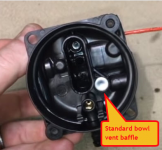
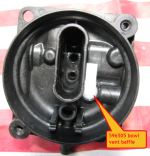
P
POM
B&S had/has a large number of 7.25, 163 cc., engines, but they are not all the same.That is a good observation POM. The "non-Smartstow" Toro model is 21462 and appears to have the same B&S engine: 7.25 ft-lb Gross Torque* Briggs & Stratton® Exi 163cc (engine model is 104M020010F1) From the B&S website, https://shop.briggsandstratton.com/pages/parts-lookup#, the carburetor part number is 594058.
Been looking into which B&S engines use the 596505 carburetor and from an on-line parts store catalog found an "applicable to" list (these are B&S engine model numbers):
104M02-0130-F1
104M02-0131-F1
104M02-0249-F1
104M02-0254-F1
I then verified on the B&S site that these engine models do indeed use the 596505 carb.
In my searching I also came across mention of the carburetor being replaced by dealers according to a bulletin to fix the sputtering problem, but the context was the Toro 21387, which has the 190 cc engine. I suspect that DSB-113/DBS-114 might apply to that engine and not the 163 cc with the 596505 carb. In this regard, Toro seems to have only four "SmartStow" models that use the 163 cc. engine: 20339, 20340, 20355, and 21386, and interestingly, reviews of these models on the Toro website also mention the sputtering issue. I haven't yet found whether the 190 cc engine on the SmartStow 21387 uses the same carburetor, although I doubt it does. But the bulletin might explain what the problem is with the carburetor and that might also be applicable to the 596505. as both would be set up for vertical storage.
According to this B&S YouTube video the Mow and Stow/SmartStow engines incorporate a number of changes:
Only two would seem to possibly be related to the sputtering issue, namely, the revised carburetor vent, and the revised governor shaft. The video shows an older, metal carb, and refers only to changing the position of one vent. However, when I compare the plastic 596505 carb to plastic carbs used on non-SmartStow models, there's several vents that are different. This is what led me to think that the sputtering is related to the different carb. And if changing the carb on the 21387 fixed sputtering, the same change to a different carburetor might fix the problem some of us have with the 163 cc engine. As for the governor, I'm not aware of any internal changes that could affect governor operation in a way that bumps would cause the governor mechanism inside to initiate a momentary throttle change.
This B&S video is a good explanation of carburetors especially because it uses the plastic one as the model:
However, the venting in the 596505 is not the same. One visually obvious difference is the bowl area vent outlet. Instead of being terminated at a simple round plug (the "baffle") in the video at around 10:15, the 596505 has a horizontal extension tube. (See photos below). This extension, I presume, is designed to prevent fuel in the bowl from spilling out through the atmospheric vent when the engine is raised in the Stow position. But I suspect that when operating on uneven surfaces, the "sloshing" fuel in the bowl might enter this short, horizontal tube, restricting or blocking the tube, and as the video notes around 10:20, when the vent is blocked, "fuel is supplied to the engine for a very short time". So, momentarily, the engine is starved, and hesitates. The governor opens the throttle, and when the vent clears, the engine fuel supply suddenly surges, leading not only to recovery but also a puff of dark smoke due to the brief "rich" fuel mix. It's only an idea, until I learn otherwise . . .


#18
P
POM
P
POM
Incidentally, this video relates to the Toro 21387 SmartStow with the 190 cc engine where comments and replies mention dealers replacing the carburetor to correct the sputtering.
#19
P
POM
P
POM
Further info:
In regard to the venting, the B&S video points out that the fuel bowl vent is to atmosphere. That is correct for a non-SmartStow carburetor I have (799584). However, the SmartStow 596505 is different. Here's a comparison:
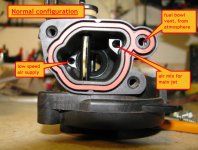
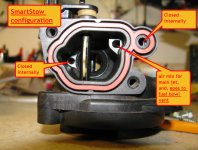
In the Normal configuration, both the "low speed air supply" and the "air mix for main jet" openings are after the air filter, with the "low speed air supply" also being after the choke. Both go to their intended locations inside the carburetor. As is apparent, the "fuel bowl vent" is separated from the carburetor inlet by the gasket, and actually opens out to atmosphere behind the air filter housing.
In the SmartStow 596505 carb, I found the "low speed air supply" and the "fuel bowl vent" passages to be closed internally, i.e., they don't go anywhere. (I could not see the low speed jet openings in the side of the venturi tubes in both carbs so that vent might not be needed.) Although the passage for the "air mix for the main jet" is the same as in the Normal configuration, in the 596505 it's also connected to passage going to the extended "fuel bowl vent" inside the fuel bowl. In other words, the fuel bowl venting in the 596505 does not originate out in atmosphere; it's after the filter.
Odd difference in the fuel bowl venting. Seems to me it would be affected by the throttle opening and the condition of the air filter. Could this be related to the sputtering that occurs when going over rough areas in the lawn?
In regard to the venting, the B&S video points out that the fuel bowl vent is to atmosphere. That is correct for a non-SmartStow carburetor I have (799584). However, the SmartStow 596505 is different. Here's a comparison:


In the Normal configuration, both the "low speed air supply" and the "air mix for main jet" openings are after the air filter, with the "low speed air supply" also being after the choke. Both go to their intended locations inside the carburetor. As is apparent, the "fuel bowl vent" is separated from the carburetor inlet by the gasket, and actually opens out to atmosphere behind the air filter housing.
In the SmartStow 596505 carb, I found the "low speed air supply" and the "fuel bowl vent" passages to be closed internally, i.e., they don't go anywhere. (I could not see the low speed jet openings in the side of the venturi tubes in both carbs so that vent might not be needed.) Although the passage for the "air mix for the main jet" is the same as in the Normal configuration, in the 596505 it's also connected to passage going to the extended "fuel bowl vent" inside the fuel bowl. In other words, the fuel bowl venting in the 596505 does not originate out in atmosphere; it's after the filter.
Odd difference in the fuel bowl venting. Seems to me it would be affected by the throttle opening and the condition of the air filter. Could this be related to the sputtering that occurs when going over rough areas in the lawn?
#20
P
POM
As noted earlier, I have a concern about the long fuel bowl vent in the 596525 SmartStow carburetor -- see photos and comment at the end of post #17 above. To test this, I removed the long vent and in its place installed the round metal disk ("baffle") from a non-SmartStow carbs, as shown in the video). If my concern is correct, this should prevent the vent from being blocked by the fuel that is sloshing around in the bowl on rough surfaces.
A relatively short trial had no sputtering despite jostling the mower; but the sputtering would often show up only somewhat later during use, so I will test this more thoroughly over the next few mowings of the lawn.
P
POM
Thanks for this report, especially noting that changing the fuel tank resolved the fuel spewing, but didn't correct the sputtering. I also observed the same fuel spraying out of the tube onto the air filter and thought it could be enriching the mixture enough to cause the engine to hesitate. However, as that doesn't seem to be the case, I turned back to the carburetor.I have the same problem with my Toro mower, model 21386, and B&S engine 104M020254F1. I notice the sputtering on bumpy terrain and inclines. Also, I discovered the gas tank on this mower has an air inlet on the side that spews gasoline into the air filter. I went ahead and replaced this with B&S part # 84004717, which fixed that issue but the sputtering continues.
As noted earlier, I have a concern about the long fuel bowl vent in the 596525 SmartStow carburetor -- see photos and comment at the end of post #17 above. To test this, I removed the long vent and in its place installed the round metal disk ("baffle") from a non-SmartStow carbs, as shown in the video). If my concern is correct, this should prevent the vent from being blocked by the fuel that is sloshing around in the bowl on rough surfaces.
A relatively short trial had no sputtering despite jostling the mower; but the sputtering would often show up only somewhat later during use, so I will test this more thoroughly over the next few mowings of the lawn.
#21
P
POM
Cut the grass today, and no sputtering/hesitation.
As noted in my post above, the only change was removal of the extended white plastic atmospheric vent outlet in the fuel bowl and replacing it with the round metal baffle. Otherwise it's the original carburetor, with the factory-spec jet for this engine.
After the engine cooled somewhat I lifted the mower into the "stow" position (fuel bowl would be full) and checked for leaks of gas from the carburetor, but nothing appeared.
It's a good sign, but I want to ensure it's repeatable. Next cutting in 4 - 8 days.
P
POM
First mowing report:I will test this more thoroughly over the next few mowings of the lawn.
Cut the grass today, and no sputtering/hesitation.
As noted in my post above, the only change was removal of the extended white plastic atmospheric vent outlet in the fuel bowl and replacing it with the round metal baffle. Otherwise it's the original carburetor, with the factory-spec jet for this engine.
After the engine cooled somewhat I lifted the mower into the "stow" position (fuel bowl would be full) and checked for leaks of gas from the carburetor, but nothing appeared.
It's a good sign, but I want to ensure it's repeatable. Next cutting in 4 - 8 days.
#22
T
tschley
T
tschley
Replacing the 596505 carburetor with part #594058 fixed the sputtering issue on my mower. If you decide to try this, keep in mind that you shouldn't store the mower on its end (Smartstow feature) with gas in it, which isn't something I do anyway. My first priority is to have a mower that runs well. It's too bad this isn't the first priority for the folks at Toro and B&S.
#23
P
POM
Did you use a genuine B&S 594058 or aftermarket?
After installing it, did you find leaking when in the vertical position?
The Toro SmartStow Super Recycler with the B&S 190 cc engine has/had the same problem, but there was a service bulletin (see comments in video in post #18 above) that involved carb replacement. Apparently it solves the problem in the Super Recycler but, presumably, also retains the SmartStow capability. If we could figure out what's different in that carburetor (to prevent sputtering) it might be possible to apply the same to the 596505, or, even just install the 190 cc replacement carb on our 163s, but swap in the 163 cc nozzle assembly from the 596505 to ensure proper fuel management. (I too always store the unit down, but occasionally make use of the vertical position for maintenance.)
P
POM
Agreed.Replacing the 596505 carburetor with part #594058 fixed the sputtering issue on my mower. If you decide to try this, keep in mind that you shouldn't store the mower on its end (Smartstow feature) with gas in it, which isn't something I do anyway. My first priority is to have a mower that runs well. It's too bad this isn't the first priority for the folks at Toro and B&S.
Did you use a genuine B&S 594058 or aftermarket?
After installing it, did you find leaking when in the vertical position?
The Toro SmartStow Super Recycler with the B&S 190 cc engine has/had the same problem, but there was a service bulletin (see comments in video in post #18 above) that involved carb replacement. Apparently it solves the problem in the Super Recycler but, presumably, also retains the SmartStow capability. If we could figure out what's different in that carburetor (to prevent sputtering) it might be possible to apply the same to the 596505, or, even just install the 190 cc replacement carb on our 163s, but swap in the 163 cc nozzle assembly from the 596505 to ensure proper fuel management. (I too always store the unit down, but occasionally make use of the vertical position for maintenance.)
#24
T
tschley
T
tschley
I used a genuine B&S part. I did not attempt to test the mower in the vertical position, but guessing it may very well leak. If we could determine the model number of the 190cc engine, the B&S website might show if the carburetor has been replaced with a different part number.Agreed.
Did you use a genuine B&S 594058 or aftermarket?
After installing it, did you find leaking when in the vertical position?
The Toro SmartStow Super Recycler with the B&S 190 cc engine has/had the same problem, but there was a service bulletin (see comments in video in post #18 above) that involved carb replacement. Apparently it solves the problem in the Super Recycler but, presumably, also retains the SmartStow capability. If we could figure out what's different in that carburetor (to prevent sputtering) it might be possible to apply the same to the 596505, or, even just install the 190 cc replacement carb on our 163s, but swap in the 163 cc nozzle assembly from the 596505 to ensure proper fuel management. (I too always store the unit down, but occasionally make use of the vertical position for maintenance.)
#25
P
POM
Like the 163 cc, there's a good number of different model numbers for the 190 cc engine. The one I've been using (it's mentioned in the Toro 21387 YouTube video comments), is 125P05-0065-F1. The carb listed for that engine is 597096, but I've not yet found any mention, in the on-line catalogs, of it being the original or a later replacement number. Perhaps I haven't looked in the right places . . .
P
POM
. . . .the B&S website might show if the carburetor has been replaced with a different part number.
Like the 163 cc, there's a good number of different model numbers for the 190 cc engine. The one I've been using (it's mentioned in the Toro 21387 YouTube video comments), is 125P05-0065-F1. The carb listed for that engine is 597096, but I've not yet found any mention, in the on-line catalogs, of it being the original or a later replacement number. Perhaps I haven't looked in the right places . . .
#26
P
POM
P
POM
Second mowing report: No sputtering/hesitation.
I do think this is it. The 596505 carburetor that's used on the B&S 163 cc engine (model series 104M02- . . . ) for Toro's SmartStow mowers has an extended atmospheric vent baffle inside the fuel bowl of the carbureter. Because the extension is horizontal along the top of the bowl, when going over bumps, shloshing fuel can get into the extension and block it. This cuts off the atmospheric air momentarily, and prevents fuel from being pushed up the main jet to the carburetor venturi area. The engine seems to stall, but it recovers as soon as the passage clears.
As reported earlier, I removed the extended baffle in my 596505 carburetor and replaced it with the flat circular baffle from from a non-SmartStow B&S carburetor. (For a description of the baffle, see the B&S Carburetor video in post #17 above.) With the flat baffle, gas that might splash up on or into the atmospheric vent drains right back out (the vent tube to the outside is essentially vertical), and it doesn't block the air supply. The engine continues to run steadily.
That's been my experience, so far. What remains problematic is the impact changing the baffle will have on the SmartStow function. (Working on that . . .)
I do think this is it. The 596505 carburetor that's used on the B&S 163 cc engine (model series 104M02- . . . ) for Toro's SmartStow mowers has an extended atmospheric vent baffle inside the fuel bowl of the carbureter. Because the extension is horizontal along the top of the bowl, when going over bumps, shloshing fuel can get into the extension and block it. This cuts off the atmospheric air momentarily, and prevents fuel from being pushed up the main jet to the carburetor venturi area. The engine seems to stall, but it recovers as soon as the passage clears.
As reported earlier, I removed the extended baffle in my 596505 carburetor and replaced it with the flat circular baffle from from a non-SmartStow B&S carburetor. (For a description of the baffle, see the B&S Carburetor video in post #17 above.) With the flat baffle, gas that might splash up on or into the atmospheric vent drains right back out (the vent tube to the outside is essentially vertical), and it doesn't block the air supply. The engine continues to run steadily.
That's been my experience, so far. What remains problematic is the impact changing the baffle will have on the SmartStow function. (Working on that . . .)
#27
P
POM
P
POM
Continuing . . .
It's my belief that the horizontal extension of the SmartStow baffle is meant to ensure that when the mower is in the vertical position, the fuel in the bowl can't leak out the vent because the opening will be above the level of the fuel. But, as noted earlier, I put my mower with the modified vent in the SmartStow position and left it for several hours and there was no sign of leakage, despite not having the extended baffle.
Did some bench testing. I clamped the spare non-SmartStow carb I have (799584) on a camera tripod so that it can be set horizontal (normal run position) and vertical (stow position).
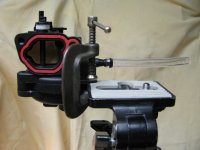
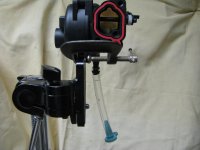
With a short clear vinyl tube attached to the fuel inlet, I flowed distilled water into the bowl until it would not take any more. This is simulating the fuel tank supply, and the inlet valve closing when the float gets high enough.
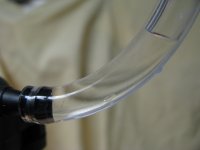
I then closed off the end of the vinyl tube, rotated the tripod mount 90 degrees, as in the vertical SmartStow position, and waited. There was no sign of leaking, even after several hours.
When the carb is vertical, the fuel inlet is the lowest passage going outside; next lowest is the atmospheric vent (with the flat, circular "baffle"); and, above that is the main nozzle jet with it's tiny opening.
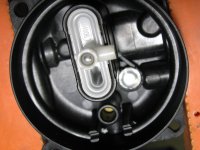
I don't know at what level the water would be in the bowl when the bowl is vertical, but imagine it's at least as high as the atmospheric vent, and would not have been surprised to see water coming out from that vent. I even rotated the carb another 45 degrees (almost up-side-down) and again expected water to come out of the atmospheric vent, but it didn't. The only rationale I can offer for it not leaking is that the water level is above the atmospheric vent opening, and with no other large path for air to get into the bowl, the water doesn't go out the vent.
With the carb in the vertical position, I then pulled the plug off the end of the short vinyl tube; water flowed out, but in this case it's coming back out through the tube that is normally attached to the fuel tank, so that would not be a problem. (In this case, the weight of the water trying to go out what is then the bottom of the bowl area is sufficient to allow atmospheric pressure at the vent to push water back from the vent baffle and supply the air needed to compensate for the water going out the fuel tank fitting.
From this it suggests that both the SmartStow and regular current black plastic carbs of the same design might normally (when all is working properly) drain back into the fuel tank when lifted into the vertical position, reducing if not eliminating the possibility of leaks.
However, if for some reason the bowl doesn't drain down into the fuel tank e.g., inlet valve remains closed, in the longer term liquid could seep out through the atmospheric vent if the liquid is higher than the vent. This could happen because the main jet, albeit a very small opening, terminates in carburetor's venturi air passage. Consequently, air could be drawn into the bowl area very slowly through the main jet and allow liquid to leak out the vent.
In the SmartStow carbs, the extended vent baffle opening is above the liquid level, and there's no risk of liquid/fuel leaking out that path when air finds its way into the bowl area.
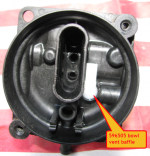
The problem for B&S is how to correct the issue of the atmospheric vent being blocked by fuel when operating (my understanding of the cause of the sputtering), while ensuring that leakage in storage can't happen. Looking at the innards of the carbs and the current passages for fuel and venting, I think it could require a significant change in the design of the upper half of the carburetor.
As an interim measure **, if the mower will be stored in the vertical position, to protect against the possibility of leakage if the bowl does not drain back to the fuel tank, a fuel shut-off valve could be added to cut the fuel supply and then run the engine until it stalls. At that time, there will be little fuel left in the bowl, and the risk of fuel exiting through the atmospheric vent because the bowl didn't drain back to the fuel tank when the mower was lifted would be low.
That's the way I see it at this point, but do I have it right? Comments, further ideas etc., encouraged and welcome.
**We know from user reports that B&S has successfully addressed the sputtering problem in at least some 190 cc SmartStow engines used by Toro, so there is a fix that, presumably, retains the SmartStow function. Goal now is to find out what that fix is, and see if it can be applied to the 163 cc SmartStow engine.
Update July 18, 2021: FWIW I ran multiple "fill - drain" tests, and every time found the bowl would self-drain when the carb is lifted from horizontal to the vertical/stow position. It took about 28 ml to fill a completely empty carburetor. In the vertical position, 20 ml drained back out the inlet tube. With the carb vertical, the remaining 8 ml is at the level of the lower edge of the large hex drain opening in the bottom part of the bowl, and at the level of the inlet valve, so well below any other paths for fuel to leak out when in the vertical position.
It's my belief that the horizontal extension of the SmartStow baffle is meant to ensure that when the mower is in the vertical position, the fuel in the bowl can't leak out the vent because the opening will be above the level of the fuel. But, as noted earlier, I put my mower with the modified vent in the SmartStow position and left it for several hours and there was no sign of leakage, despite not having the extended baffle.
I had thought that as well. But your substitution of the 594098, which is for the 163 cc but not SmartStow, seems to be a viable solution, with precautions as described below.I did not attempt to test the mower in the vertical position, but guessing it may very well leak.
Did some bench testing. I clamped the spare non-SmartStow carb I have (799584) on a camera tripod so that it can be set horizontal (normal run position) and vertical (stow position).


With a short clear vinyl tube attached to the fuel inlet, I flowed distilled water into the bowl until it would not take any more. This is simulating the fuel tank supply, and the inlet valve closing when the float gets high enough.

I then closed off the end of the vinyl tube, rotated the tripod mount 90 degrees, as in the vertical SmartStow position, and waited. There was no sign of leaking, even after several hours.
When the carb is vertical, the fuel inlet is the lowest passage going outside; next lowest is the atmospheric vent (with the flat, circular "baffle"); and, above that is the main nozzle jet with it's tiny opening.

I don't know at what level the water would be in the bowl when the bowl is vertical, but imagine it's at least as high as the atmospheric vent, and would not have been surprised to see water coming out from that vent. I even rotated the carb another 45 degrees (almost up-side-down) and again expected water to come out of the atmospheric vent, but it didn't. The only rationale I can offer for it not leaking is that the water level is above the atmospheric vent opening, and with no other large path for air to get into the bowl, the water doesn't go out the vent.
With the carb in the vertical position, I then pulled the plug off the end of the short vinyl tube; water flowed out, but in this case it's coming back out through the tube that is normally attached to the fuel tank, so that would not be a problem. (In this case, the weight of the water trying to go out what is then the bottom of the bowl area is sufficient to allow atmospheric pressure at the vent to push water back from the vent baffle and supply the air needed to compensate for the water going out the fuel tank fitting.
From this it suggests that both the SmartStow and regular current black plastic carbs of the same design might normally (when all is working properly) drain back into the fuel tank when lifted into the vertical position, reducing if not eliminating the possibility of leaks.
However, if for some reason the bowl doesn't drain down into the fuel tank e.g., inlet valve remains closed, in the longer term liquid could seep out through the atmospheric vent if the liquid is higher than the vent. This could happen because the main jet, albeit a very small opening, terminates in carburetor's venturi air passage. Consequently, air could be drawn into the bowl area very slowly through the main jet and allow liquid to leak out the vent.
In the SmartStow carbs, the extended vent baffle opening is above the liquid level, and there's no risk of liquid/fuel leaking out that path when air finds its way into the bowl area.

The problem for B&S is how to correct the issue of the atmospheric vent being blocked by fuel when operating (my understanding of the cause of the sputtering), while ensuring that leakage in storage can't happen. Looking at the innards of the carbs and the current passages for fuel and venting, I think it could require a significant change in the design of the upper half of the carburetor.
As an interim measure **, if the mower will be stored in the vertical position, to protect against the possibility of leakage if the bowl does not drain back to the fuel tank, a fuel shut-off valve could be added to cut the fuel supply and then run the engine until it stalls. At that time, there will be little fuel left in the bowl, and the risk of fuel exiting through the atmospheric vent because the bowl didn't drain back to the fuel tank when the mower was lifted would be low.
That's the way I see it at this point, but do I have it right? Comments, further ideas etc., encouraged and welcome.
**We know from user reports that B&S has successfully addressed the sputtering problem in at least some 190 cc SmartStow engines used by Toro, so there is a fix that, presumably, retains the SmartStow function. Goal now is to find out what that fix is, and see if it can be applied to the 163 cc SmartStow engine.
Update July 18, 2021: FWIW I ran multiple "fill - drain" tests, and every time found the bowl would self-drain when the carb is lifted from horizontal to the vertical/stow position. It took about 28 ml to fill a completely empty carburetor. In the vertical position, 20 ml drained back out the inlet tube. With the carb vertical, the remaining 8 ml is at the level of the lower edge of the large hex drain opening in the bottom part of the bowl, and at the level of the inlet valve, so well below any other paths for fuel to leak out when in the vertical position.
#29
P
POM
The Toro site to search for the bulletins seems to be https://lookup3.toro.com/request/request.cfm?xcaller=Toro, and it requires both the mower model number and unit serial number.
The service bulletin "DSB-113/DBS-114" in post #1 of this thread relates to Toro model 21387 (but same symptoms as the OP's 21386 model). The 21387 is the subject of the YouTube video where the service bulletin is identified in the comments. Unfortunately, none of the comments include a Toro serial number, so the above Toro site can't be used to search for the bulletin. Is there another site that doesn't require the serial number?
Here's one of the video comments mentioning the service bulletin; it's for a Toro 21387:
"Just picked up my lawnmower from Home Depot. The service report says carburetor was the issue. Also it says “See Bulletin DSB-113/ DBS-114 For instructions on filing the claim.” Not sure if this is related but it gives the engine model #125P050065F1 s/n 1912029059946."
Although the comments to the video suggest that the carburetor was replaced by the Toro dealer, the bulletin might originate with Briggs & Stratton, rather than Toro.
P
POM
Thanks, but where did you check, and for which mower model?There were no service bulletins located for that mower on the Toro website.
The Toro site to search for the bulletins seems to be https://lookup3.toro.com/request/request.cfm?xcaller=Toro, and it requires both the mower model number and unit serial number.
The service bulletin "DSB-113/DBS-114" in post #1 of this thread relates to Toro model 21387 (but same symptoms as the OP's 21386 model). The 21387 is the subject of the YouTube video where the service bulletin is identified in the comments. Unfortunately, none of the comments include a Toro serial number, so the above Toro site can't be used to search for the bulletin. Is there another site that doesn't require the serial number?
Here's one of the video comments mentioning the service bulletin; it's for a Toro 21387:
"Just picked up my lawnmower from Home Depot. The service report says carburetor was the issue. Also it says “See Bulletin DSB-113/ DBS-114 For instructions on filing the claim.” Not sure if this is related but it gives the engine model #125P050065F1 s/n 1912029059946."
Although the comments to the video suggest that the carburetor was replaced by the Toro dealer, the bulletin might originate with Briggs & Stratton, rather than Toro.
#30

wingless
The OP can use the exact info.
wingless
Used that model number and a fake serial number.Thanks, but where did you check, and for which mower model?
The Toro site to search for the bulletins seems to be https://lookup3.toro.com/request/request.cfm?xcaller=Toro, and it requires both the mower model number and unit serial number.
The service bulletin "DSB-113/DBS-114" in post #1 of this thread relates to Toro model 21387 (but same symptoms as the OP's 21386 model). The 21387 is the subject of the YouTube video where the service bulletin is identified in the comments. Unfortunately, none of the comments include a Toro serial number, so the above Toro site can't be used to search for the bulletin. Is there another site that doesn't require the serial number?
Here's one of the video comments mentioning the service bulletin; it's for a Toro 21387:
The OP can use the exact info.
#31
P
POM
P
POM
As the search for the service bulletins on the Toro site requires the serial number, it's possible that only serial numbers covered by the service bulletin will result in positive response.
The OP has a 21386 rather than a 21387 which is the model covered by the service bulletin. But as the problem of sputtering is the same in both models (albeit different size engines), the service bulletin covers replacing the carburetor, and that corrects the problem in the 21387, the 21387 replacement carb could reveal what change is made (relative to the factory-installed carb) and that might be applicable to the 21386 carb, even though there might not be a corresponding bulletin for the 21386.
Thanks for trying.
The OP has a 21386 rather than a 21387 which is the model covered by the service bulletin. But as the problem of sputtering is the same in both models (albeit different size engines), the service bulletin covers replacing the carburetor, and that corrects the problem in the 21387, the 21387 replacement carb could reveal what change is made (relative to the factory-installed carb) and that might be applicable to the 21386 carb, even though there might not be a corresponding bulletin for the 21386.
Thanks for trying.
#32
F
FlaMower
F
FlaMower
I seem to have the same issue with my 21462 (9 months old). After engine is warm, it will sporadically sputter then immediately resume. I only run ethanol free gas (works fine with other B&S engines), changed spark plug and air filter, but sputter continues. All symptoms points to a carb issue. I have not taken it to a service facility as this is my only mower and I can't "not mow" for a couple/few weeks while it's in the shop. If the fix is replace the carb, wonder if Toro would just ship me one?That is a good observation POM. The "non-Smartstow" Toro model is 21462 and appears to have the same B&S engine: 7.25 ft-lb Gross Torque* Briggs & Stratton® Exi 163cc (engine model is 104M020010F1) From the B&S website, https://shop.briggsandstratton.com/pages/parts-lookup#, the carburetor part number is 594058.
#33
M
Marty013
M
Marty013
20355 model here, same symptoms, this is with a briggs 163cc engine.. dealer is of absolutely no help on this one.. i wonder if carb B&S 594058 would work out?? seems OP has the 190cc engine?? when i google B&S 594058 carb, it looks like theres a vent tube like the stow an go carbs? is this indicative it wont fix the sputtering issue? dealer just wants to grab a service call.. we can look at it.. but theres no fix.. apparently.. so driving 1.5hrs just to empty my pockets doesnt sound like a fun thing to try 
#35
M
Marty013
M
Marty013
serial of the mower itself; 4024 16964
serial on the engine if this is what your asking; 1705 1958 36977
serial on the engine if this is what your asking; 1705 1958 36977
#36
H
HonToro
I bought a used super recycler with the 163cc engine, cleaned the carb, cleaned the fuel tank, replaced spark plug and air filter, and I only use ethanol free gas. It still sputters when on bumpy ground, going up a slight grade, and when slightly tilted mowing around trees. When mowing flat smooth parts of my lawn its fine. My model is 21386.
Will carb model number 594058 fixe this issue?
H
HonToro
Replacing the 596505 carburetor with part #594058 fixed the sputtering issue on my mower. If you decide to try this, keep in mind that you shouldn't store the mower on its end (Smartstow feature) with gas in it, which isn't something I do anyway. My first priority is to have a mower that runs well. It's too bad this isn't the first priority for the folks at Toro and B&S.
I bought a used super recycler with the 163cc engine, cleaned the carb, cleaned the fuel tank, replaced spark plug and air filter, and I only use ethanol free gas. It still sputters when on bumpy ground, going up a slight grade, and when slightly tilted mowing around trees. When mowing flat smooth parts of my lawn its fine. My model is 21386.
Will carb model number 594058 fixe this issue?
#37
H
HonToro
H
HonToro
Just installed the 596505 carburetor and I think it fixed my sputtering over bumpy uneven terrain. I have to do a full mow to make sure. Thanks for the help.Replacing the 596505 carburetor with part #594058 fixed the sputtering issue on my mower. If you decide to try this, keep in mind that you shouldn't store the mower on its end (Smartstow feature) with gas in it, which isn't something I do anyway. My first priority is to have a mower that runs well. It's too bad this isn't the first priority for the folks at Toro and B&S.
